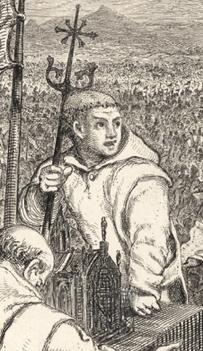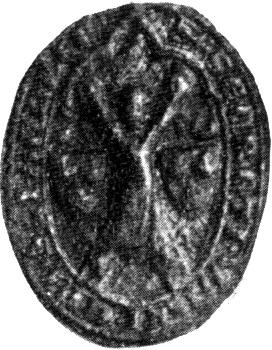William de Lamberton facts for kids
Quick facts for kids William Lamberton |
|
|---|---|
| Bishop of St Andrews | |
 |
|
| Church | Roman Catholic Church |
| Diocese | St Andrews |
| In Office | 1297–1328 |
| Predecessor | William Fraser |
| Successor | James Bane |
| Orders | |
| Consecration | 1 June 1298 by Matteo d'Acquasparta |
| Personal details | |
| Born | unknown Possibly Ayrshire or Lamberton, near Berwick |
| Died | 30 May 1328 |
| Previous post | Chancellor of Glasgow Cathedral |
William Lamberton (died 20 May 1328) was an important Scottish leader. He served as the Bishop of St Andrews from 1297 until his death. Bishop Lamberton played a huge part in the Scottish Wars of Independence. He supported famous figures like William Wallace and later Robert the Bruce.
As Bishop of St Andrews, he held a very powerful position in Scotland. He even helped crown Robert the Bruce as King Robert I. Lamberton also helped create important documents like the Declaration of the Clergy and the Declaration of Arbroath. These documents were key to Scotland gaining its independence.
During his time, Lamberton faced challenges from Rome. He was briefly removed from the church for his role in the Wars of Independence. However, he made peace with the Papacy before he died.
Contents
Early Life of William Lamberton
William Lamberton likely came from the Lamberton family. This family was originally from Berwickshire. They also owned land in other parts of Scotland. We don't know exactly when he was born.
By 1293, he had finished university. He became a church official, called a canon, in Glasgow. He was also the chancellor of Glasgow Cathedral. He might have studied more abroad around 1295.

His family name, Lamberton, is linked to a place near Berwick. This is where his family had large estates.
Becoming Bishop of St Andrews
In 1298, Pope Boniface VIII chose William Lamberton to be the Bishop of St Andrews. This was a big surprise because he was quite young. However, historian Geoffrey Barrow suggests that William Wallace, who was then the Guardian of Scotland, helped him get the job. Wallace saw Lamberton as someone who would support Scottish independence.
St Andrews was the richest and most powerful church area, called a See, in Scotland. Becoming bishop there put Lamberton right at the top of Scottish society. The English later claimed Wallace forced the church to choose Lamberton. But evidence shows Lamberton was a popular choice among the church leaders.
He was officially made bishop in Rome on June 1, 1298. After that, he joined other Scots on a trip to France to discuss important matters.
Bishop Lamberton also took a young James Douglas under his care. Douglas's father had fought for Scotland and died in an English prison. Lamberton tried to help Douglas get his family lands back. James Douglas later became a close friend of Robert the Bruce.
William Lamberton helped rebuild many important buildings. These included St. Andrew's Cathedral and the castle of St Andrew's. He also rebuilt several fortified manor houses.
Fighting for Scottish Freedom
When Lamberton became bishop, he controlled a lot of money from the church. He used these funds to help pay for the war against England. He also worked as an important diplomat for Scotland. Lamberton always supported Scotland's independence. He was even briefly removed from the church for his actions.
A Diplomat for Scotland
After becoming bishop, Lamberton went to France. His goal was to get support for Scotland from the French King and the Pope. By June 1298, he had already made progress. His efforts led both King Philip IV of France and Pope Boniface VIII to ask Edward I of England to stop attacking Scotland.
In 1299, Scotland's former king, John Balliol, was even handed over to the Pope. King Philip IV praised Lamberton's work in a letter in 1299. He promised to help Scotland. Lamberton returned to France in 1301 and 1302 to keep asking for French support. He formed a strong connection with King Philip.
Lamberton's skills as a diplomat were recognized by Scottish leaders. In 1299, he was chosen to be a third Guardian of Scotland. He served alongside Robert Bruce and John Comyn. His job was to be a neutral leader between these two rivals. He held this position until 1301. During this time, he became good friends with Bruce.
Supporting William Wallace
Lamberton owed his position as bishop partly to William Wallace. Wallace had become the sole Guardian of Scotland after the Battle of Stirling Bridge in 1297. Because of this, Lamberton strongly supported Wallace.
Lamberton's church officials spoke out against the English. They also supported Wallace's efforts. Lamberton ordered church money to be used for Wallace's fight. He encouraged Wallace to keep fighting England. Even after Wallace resigned as Guardian, Lamberton continued to support Scottish independence.
His Friendship with Robert the Bruce
Lamberton became close with Bruce during his time as Guardian. He saw Bruce as a possible leader for the fight for independence. On June 11, 1304, Lamberton and Bruce made a special promise. They agreed to help each other against rivals and work together. This promise showed Lamberton's support for Bruce.
Lamberton and Bishop Wishart of Glasgow told Bruce they would not stop him if he tried to become king. Bruce and his companions killed a rival, Red Comyn, in February 1306. Less than two months later, Bruce was crowned King of Scots. This happened at Scone Abbey on March 25, 1306. Lamberton and Wishart together performed the coronation.
Because of their role, Lamberton and Wishart were arrested. They were sent to London and put in prison. Their church positions saved them from a worse fate. Lamberton was later accused of treason against the English king.
After King Edward I died, Lamberton promised loyalty to his son, Edward II. The bishop was released in August 1308. He had to agree to difficult terms. He promised to go after the king's enemies and pay a large sum of money. He also had to stay within a certain area.
Lamberton felt he had to make this promise. He saw it as forced and therefore not truly valid. While in England, he stayed near the border. This allowed him to keep in touch with parts of his church area under English rule. Lamberton also wrote to the King of France for help to gain his freedom.
In 1309, Lamberton attended talks as an "English" representative. His diplomatic skills helped him stay on good terms with both Edward and Robert. Lamberton never worked with the English again. Edward even tried to have him removed as bishop in 1318. But Edward's efforts failed.
In 1323, Lamberton and Thomas Randolph, 1st Earl of Moray were Scottish negotiators. They helped agree to a thirteen-year truce between Scotland and England.
Excommunication and Reconciliation
Lamberton and three other bishops were asked to go to Avignon. They were meant to explain their actions to the Pope. But they refused to go. Lamberton was officially removed from the church on June 16, 1320.
King Robert and the Scottish community sent letters to Pope John XXII. The most famous of these is the Declaration of Arbroath. This declaration received some positive responses. However, because of pressure from England, the Pope continued the excommunications. But thanks to a personal plea by Thomas Randolph, 1st Earl of Moray in 1325, the Pope did recognize Robert the Bruce as King of Scots.
Death
Bishop William de Lamberton died on May 20, 1328. This was just 18 days after England officially recognized Scotland as a fully independent country. He was buried on June 7, 1328, at St Andrews Cathedral.
See also
- Lambroughton A History of the Lands of Lambroughton
Sources
- McNaught, Duncan (1912). Kilmaurs Parish and Burgh. Pub. A.Gardner.
- Barrow, Geoffrey Robert Bruce and the Community of The Realm Of Scotland.
- St. Andrews - Bishop William Lamberton
- Ancestry - Lamberton
- James Lord of Douglas
| Religious titles | ||
|---|---|---|
| Preceded by William Fraser |
Bishop of St. Andrews 1297/8-1328 |
Succeeded by James Bane |

